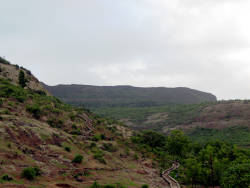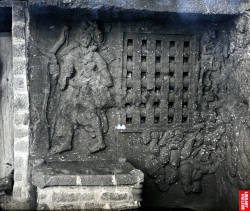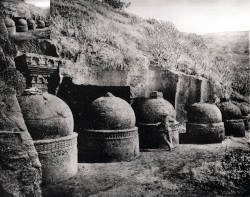तिभाजे बुद्ध लेणी
Bhaja Buddhist Caves
Useful Information


| Location: |
Baje Caves Rd, Malawali N.m., Maharashtra 410405.
12 km from Lonaviala and about 126 km south-east of Bombay on the main railway line to Pune. Alight at Malavali railway station and take the road south to the caves which are about a 3 km away. (18.728393, 73.481546) |
| Open: |
All year daily 9-17:30. [2025] |
| Fee: |
Foreigners INR 300, Indians INR 25. [2025] |
| Classification: |
 Cave Church Cave Church
|
| Light: | bring torch |
| Dimension: | |
| Guided tours: | self guided |
| Photography: | allowed |
| Accessibility: | no |
| Bibliography: | |
| Address: | Bhaja Caves, Bhaje Caves Road, District, near Bhaja Village, Maval, Lonavla, Maharashtra 412106. |
| As far as we know this information was accurate when it was published (see years in brackets), but may have changed since then. Please check rates and details directly with the companies in question if you need more recent info. |
|
History
| 200 BC | caves excavated. |
| 05-MAY-1909 | protected as a Monument of National Importance by the Archaeological Survey of India per Notification No. 2407-A. |
Description



It is a 3 km walk or ride up the hill to the 18 Bhaja Caves. Cave No 12, a chaitya similar in style to the Karla Cave, is the most important. About 50 m past this is a strange group of 14 stupas, (domed shaped pagodas) five inside and nine outside. The last cave on the south side has some fine sculptures, including the famous Dancing Couple.
Text by Tony Oldham (2003). With kind permission.
The भाजे बुद्ध लेणी (Bhājē bud'dha lēṇī, Bhaje Buddha Caves) are named after the village of Bhaja or Bhaje right below the hill, 22 rock-cut caverns make up the Bhaja Buddhist cave complex, very similar to the more famous Karla Caves in their architecture. At the center is a large prayer hall called the Chaitya Griha which is about 4 m wide an 8 m high and has a barrel vault. The lower half of the wall are octagonal pillars which allow passage to the two side aisles, which are only half as high and quite narrow. At the end of the main aisle is a sort of apsis with a massive round stupa with a semi-spherical roof and a small cube-shaped relic box on top. This structure was also hewn from solid rock, like the temples. Actually there are 14 stupas, which are an important feature of this place. Two have the relic boxes of the resident monks who once lived there on top. There is an inscriptions with the names of three monks: Ampinika, Dhammagiri, and Sanghdina.
The temples are quite different, some have a single entrance, others three, some have a door and a window on each side, some have pillars in the front, others look almost like natural cave portals. The temples are at different heights of a cliff face, they do not even form identifiable levels. Some of the caves have runic inscriptions or reliefs on the walls inside. The temples were built about 2,200 years BP, about 120 m above the village but at an ancient trade route along the hillside connecting the Arabian Sea eastward to the Deccan Plateau. They were dug by the Hinayana Buddhist sect of Maharashtra.
One of the strange details in the Chaitya Griha is the fact that the pillars are built like they would be in a wooden building. But the rock-hewn version has different statics, and so this makes actually no sense. It seems they intentionally copied the wooden building. And at the same time, as those wooden buildings are long gone, we have a detailed example how they looked more than 2,000 years ago.
Quite interesting are the numerous inscriptions and reliefs. One shows a woman playing tabla and another woman dancing. Tabla is a percussion instrument, and this depiction proves that it was used in India for at least 2300 years. Over centuries, it was believed that the tabla was introduced to India by outsiders or from Turko-Arab. Other reliefs show unique motives from Indian mythology and some Buddha images. There is also inscriptions showing the name of a donor, for example Maharathi Kosikiputa Vihnudata.
The best way to reach the village Bhaja is by train, it has a railway station at Malavli. From the train station its 2.2 km/30 minutes hike to the other side of the village and halfway up the hill to the ticket office. By car its Mumbai-Satara highway exit Lonavala/Karla. Or travel to Lonavala and take a taxi, it’s about 20 minutes by car. We recommend trekking shoes, sun protection, water, and a torch. The site is well known and may get crowded on weekends.
- See also
 Search DuckDuckGo for "Bhaja Buddhist Caves "
Search DuckDuckGo for "Bhaja Buddhist Caves " Google Earth Placemark
Google Earth Placemark Bhaja Caves - Wikipedia (visited: 15-OCT-2025)
Bhaja Caves - Wikipedia (visited: 15-OCT-2025) Bhaja Caves - Atlas Obscura (visited: 15-OCT-2025)
Bhaja Caves - Atlas Obscura (visited: 15-OCT-2025) The Ancient Buddhist Caves of Bhaja (visited: 15-OCT-2025)
The Ancient Buddhist Caves of Bhaja (visited: 15-OCT-2025) Bhaja Caves – A Hidden Gem of Ancient Buddhist Architecture in Maharashtra (visited: 15-OCT-2025)
Bhaja Caves – A Hidden Gem of Ancient Buddhist Architecture in Maharashtra (visited: 15-OCT-2025) Bhaja Caves: History, Timings, Location, How To Reach! (visited: 15-OCT-2025)
Bhaja Caves: History, Timings, Location, How To Reach! (visited: 15-OCT-2025)
 Index
Index Topics
Topics Hierarchical
Hierarchical Countries
Countries Maps
Maps